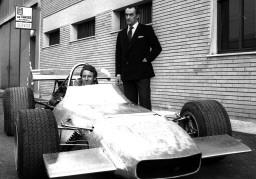The De Tomaso automobile marque will be put up for auction here on Wednesday, five years after the death of the company's founder, Italo-Argentinian Alejandro De Tomaso.
The base price for the auction, to be held at the office of notary Monica Rossi, will be 1.78 million euros.
Another auction will be held at Rossi's office on July 3 for the company's real estate assets with a starting price of 7.631 million euros.
These include a 1,000sqm office building, two warehouses and two smaller buildings.
The De Tomaso Modena automobile company was placed into liquidation in 2004, a year after the founder's death.
De Tomaso, who died of heart disease here on May 21, 2003 at the age of 74, was born in Buenos Aires but migrated to Italy in 1955, during the regime of Juan Peron, and made Modena his adopted home.
His father, the son of an immigrant Neapolitan laborer, was an eminent politician who had been minister of agriculture in the 1930s. His mother belonged to one of the oldest Hispanic families which originally controlled Argentinian agriculture.
Opposed to the Peronist regime, De Tomaso came to Italy where he raced for Maserati and married American millionairess Isebella Haskell, who was also a racecar driver.
But after four years he left driving and set up his own automobile plant to make exclusive, handmade automobiles.
The cars he produced at his plant have included the now legendary Vallelunga, Mangusta, Kafir, Pantera, Guara' and those just bearing his name.
In 1966 De Tomaso presented at the Geneva Car Show his 8 cylinder, 2000cc Barchetta, penned by Giorgetto Giugiaro, who the year before began working at the Italian chassis and design company Ghia.
Ghia became a De Tomaso possession in 1967.
The unexpected success of the Mangusta convinced Ford to buy 80% of De Tomaso's company and for the Detroit automaker De Tomaso produced the acclaimed Pantera, a sedan designed by American Tom Tjaarda.
In 1970, De Tomaso decided to try his luck with Formula 1 and put together a team which included Giampaolo Dallara as project leader and Frank Williams as team manager.
However, De Tomaso lost interest in Formula 1 after his 28-year old British driver, Piers Courage, was killed in the season's fourth race.
Dallara stuck with racing and continues to successfully design and produce cars, while Williams set up his own Formula 1 team which he still owns and runs.
De Tomaso, meanwhile, went on to build the Deauville and the Longchamp cars and purchased the Benelli and Moto Guzzi motorcycle companies.
In 1973, after selling Ghia to Ford, he took over Innocenti which built the new model of English Mini designed by Bertone and in 1976 he used state aid to acquire Maserati.
He merged the two companies in 1984, the year he produced the classic and highly successful Maserati Bi-Turbo.
That same year Lido Iacocca asked De Tomaso to produce a convertible coupe': the Chrysler-Maserati TC, 7,500 of which were produced in Italy between 1987 and 1990.
De Tomaso sold 49% of Maserati to Fiat in 1990 and the rest in 1993 after he suffered a crippling stroke. He also sold Moto Guzzi.
Despite his failing health, De Tomaso's mind remained active and while continuing to produce sports cars in Modena he embarked on a new industrial venture, setting up a plant in Calabria in the late 1990s to produce a European version of the Russian UAZ jeep.









